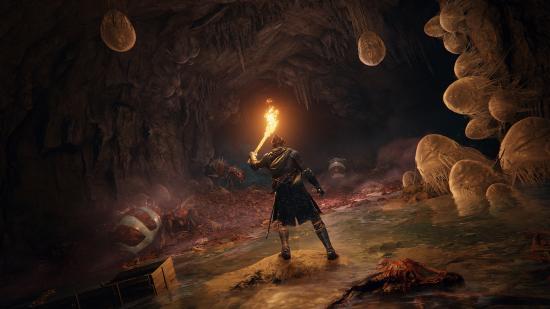Elden Ring’s Shadow of the Erdtree DLC has finally arrived, and you’re going to need the best settings possible to tackle the Lands of Shadow if you hope to survive.
Developer FromSoftware hasn’t really changed its approach to PC ports since Dark Souls 2, so veterans of the studio’s games should feel right at home in the settings menu.
Despite this, some bad habits have also made their way into the PC port of Elden Ring and have remained in place ever since. The game is limited to 60fps and features no ultrawide monitor support, as with previous FromSoftware Soulsborne games. There’s also no sign of upscaling features like AMD FSR or Nvidia DLSS, or other technologies unique to the platform like Nvidia Reflex. Mods can be downloaded to add many of these features, but it’s a hassle that could easily be avoided.
Here’s what you’ll need to wander The Lands Between, the Lands of Shadow, and meet the Elden Ring system requirements:
| Minimum | Recommended | |
| OS | Windows 10 | Windows 10 Windows 11 |
|---|---|---|
| CPU | AMD Ryzen 3 3300X Intel Core i5-8400 |
AMD Ryzen 5 3600X Intel Core i7-8700K |
| RAM | 12GB | 16GB |
| GPU | AMD Radeon RX 580 Nvidia GeForce GTX 1060 |
AMD Radeon RX Vega 56 Nvidia GeForce GTX 1070 |
| VRAM | 3-4GB | 8GB |
| Storage | 60GB | 60GB |
Before we get started, you should download an fps monitor so you can keep an eye on your frame rate before and after any changes you make. This will help make sure you’re making the right changes.
Best Elden Ring presets
Of the four presets available in Elden Ring’s settings menu, we recommend that most people opt for the ‘High’ preset for several reasons. For starters, it’s the best option for those looking for a degree of elevated visual fidelity without sacrificing too much in terms of performance. The ‘Max’ preset does offer some subtle improvements, but you won’t miss them too much if you can’t quite hit 60fps cap while using it.
More importantly, moving down to ‘Medium’ can unfortunately leave the game looking noticeably worse, with ‘Low’ compounding this problem by some magnitude. In fact, these presets compromise the look of Elden Ring to the point that we explicitly don’t recommend that anyone use either of these presets if it can be helped. This discommendation comes despite ‘Medium’ offering an 8% performance uplift versus ‘High.’ However, if you’re not satisfied with the frame rates you’re experiencing using our recommended preset, we do have a some solutions for you in our more granular settings recommendations further down.
So, while there is some room to improve your level of performance in Elden Ring, it comes at a substantial cost to the quality of the game’s visual presentation. This speaks to a wider issue with the game’s limited scalability, as its 60fps cap prevents rigs equipped with the best graphics cards from making use of their extra horsepower. Worse still, many players will be using Steam’s most popular GPU, the Nvidia GeForce GTX 1060, which is what FromSoftware says you’ll need in order to meet the game’s minimum system requirements.
Best Elden Ring settings
Here are the best Elden Ring settings:
- Texture Quality: High
- Antialiasing: High
- SSAO: High
- Depth of Field: High
- Motion Blur: High
- Shadow Quality: High
- Lighting Quality: High
- Effects Quality: High
- Volumetric Quality: High
- Reflection Quality: High
- Water Surface Quality: High
- Shader Quality: High
- Global Illumination Quality: High
- Grass Quality: High
Since Elden Ring doesn’t feature a built-in benchmark, we used a wide variety of the game’s outdoor and indoor environments as testing grounds to establish our recommended settings. Unfortunately, there aren’t any individual settings that have a profound impact on the game’s average frame rates, which is disappointing, to say the least. Nevertheless, we do have some recommendations for those who want to tinker past the standard presets
The main reason we do not recommend using the ‘Medium’ preset is due to how it affects the shadow quality setting. When set below ‘High’, shadows in the game world will flicker in an extremely distracting manner, which becomes even worse when set to ‘Low’. As such, we strongly recommend nudging this setting to ‘High’ if you opt for the game’s ‘Medium’ preset.
The only other way to significantly boost fps is by reducing your game’s rendering resolution. This should not only help with making frame rates more stable across Elden Ring’s vast and varied environments, but it will also reduce VRAM usage too. It’s disappointing that FromSoftware couldn’t include upscaling features like Nvidia DLSS or AMD FSR as an alternative means of increasing the game’s performance, and we hope the company can patch either of these solutions in post-launch.
Elden Ring Accessibility Settings
Elden Ring unfortunately doesn’t feature much in the way of accessibility settings, opting for a basic assortment of subtitle toggles and the ability to change its keybindings. However, players are limited in their ability to edit their control scheme on gamepads, with functions such as movement locked to the left thumbstick.
Accessibility reviewer Steve Saylor offers some further criticisms of Elden Ring’s lack of accessibility options, describing it as an “accessibility nightmare.” Saylor highlights the absence of menu narration, small text size, difficult to read fonts, visual indicators, in addition to many more settings.
Elden Ring has overcome some big performance issues on PC over the last year and we coined it a “masterpiece” in our Elden Ring review. This only got better as seen in our Shadow of the Erdtree review, which we call one of “the best videogame expansions of all time”.
For more, you can find out how to start the Shadow of the Erdtree DLC and read about a quirky Steam Deck bug that cropped up during the recent game update.



